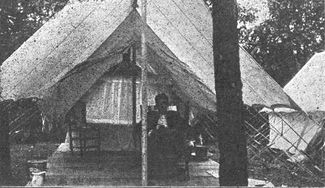Jefferson Tuberculosis Sanatorium: Difference between revisions
No edit summary |
No edit summary |
||
| Line 8: | Line 8: | ||
In [[1921]] the Association relocated to a newly-donated 45-acre site off of [[Old Montgomery Highway (Homewood)|Montgomery Highway]] in [[Shades Valley]]. A new facility, now called the [[Davenport Building]] was designed by architect [[Bem Price]]. The anticipated budget for the building was around $110,000, but when it opened on [[June 3]], [[1925]] it was reported that $250,000 had been spent. A "[[Third Main Building]]" was completed adjoining it in [[1937]]. | In [[1921]] the Association relocated to a newly-donated 45-acre site off of [[Old Montgomery Highway (Homewood)|Montgomery Highway]] in [[Shades Valley]]. A new facility, now called the [[Davenport Building]] was designed by architect [[Bem Price]]. The anticipated budget for the building was around $110,000, but when it opened on [[June 3]], [[1925]] it was reported that $250,000 had been spent. A "[[Third Main Building]]" was completed adjoining it in [[1937]]. | ||
In the 1940s, wide distribution of antibiotics provided a more reliable treatment for tuberculosis, though the disease remained a leading cause of death in the county well into the 1950s. The former tuberculosis sanitorium was repurposed in [[1973]] as [[Lakeshore Hospital]], now the [[Lakeshore Foundation]]'s [[Lakeshore Rehabilitation Hospital]]. | In the 1940s, wide distribution of antibiotics provided a more reliable treatment for tuberculosis, though the disease remained a leading cause of death in the county well into the 1950s. [[Donald Comer Jr]] wrote of a Sunday afternoon visit to the sanatorium with the [[Alabama Boys School Industrial Band]] in [[1948]]. He observed that "there is some division of the patients— those confined to bed are in one building and those who were further along with recovery are in another building and then the Negro patients in another." | ||
The former tuberculosis sanitorium was repurposed in [[1973]] as [[Lakeshore Hospital]], now the [[Lakeshore Foundation]]'s [[Lakeshore Rehabilitation Hospital]]. | |||
==References== | ==References== | ||
* {{Cruikshank-1920}} | * {{Cruikshank-1920}} | ||
* "[http://bplonline.cdmhost.com/digital/collection/p4017coll8/id/32697 Bidders on Jefferson Tuberculosis Sanitorium]" (May 25, 1924) ''The Dixie Manufacturer'', Vol. 54, No. 10, p. 18 | * "[http://bplonline.cdmhost.com/digital/collection/p4017coll8/id/32697 Bidders on Jefferson Tuberculosis Sanitorium]" (May 25, 1924) ''The Dixie Manufacturer'', Vol. 54, No. 10, p. 18 - via {{BPLDC}} | ||
* Comer, Donald Jr (October 11, 1948) "[https://cdm16044.contentdm.oclc.org/digital/collection/p15099coll4/id/11704/rec/4 Donald Comer Writes]." ''[[The Avondale Sun]]'' Vol. 26, No. 19, pp. 1,5,8 - via {{BPLDC}} | |||
[[Category:Hospitals]] | [[Category:Hospitals]] | ||
Revision as of 09:51, 10 January 2024
The Jefferson Tuberculosis Sanatorium was a series of medical facilities constructed by the Anti-Tuberculosis Association of Jefferson County for the treatment of patients infected with tuberculosis, often also called "consumption". In the early 20th century, the prevailing treatment for infection was sunlight and fresh air.
At the urging of Reverend George Eaves and health officer Robert Harkness, an Anti-Tuberculosis Association of Jefferson County was established in 1910 and erected an infirmary, originally consisting of canvas tents on Cahaba Road in what is now English Village. The project was supported by the Birmingham Chapter of the American Red Cross, the Board of Lady Managers for Hillman Hospital (which did not admit infectious patients), the Graduate Nurses Association, and various public and private organizations. It accepted its first patient in August 1910 and treated 78 people over the course of its first year, reporting good results.
A framed building, called the Red Mountain Sanitarium, was completed in 1914. The society treated both white and Black patients at the sanitarium.
In 1921 the Association relocated to a newly-donated 45-acre site off of Montgomery Highway in Shades Valley. A new facility, now called the Davenport Building was designed by architect Bem Price. The anticipated budget for the building was around $110,000, but when it opened on June 3, 1925 it was reported that $250,000 had been spent. A "Third Main Building" was completed adjoining it in 1937.
In the 1940s, wide distribution of antibiotics provided a more reliable treatment for tuberculosis, though the disease remained a leading cause of death in the county well into the 1950s. Donald Comer Jr wrote of a Sunday afternoon visit to the sanatorium with the Alabama Boys School Industrial Band in 1948. He observed that "there is some division of the patients— those confined to bed are in one building and those who were further along with recovery are in another building and then the Negro patients in another."
The former tuberculosis sanitorium was repurposed in 1973 as Lakeshore Hospital, now the Lakeshore Foundation's Lakeshore Rehabilitation Hospital.
References
- Cruikshank, George H. (1920) History of Birmingham and Its Environs: A Narrative Account of Their Historical Progress, Their People, and Their Principal Interests 2 volumes. Chicago, Illinois: Lewis Publishing Company. - via Birmingham Public Library Digital Collections
- "Bidders on Jefferson Tuberculosis Sanitorium" (May 25, 1924) The Dixie Manufacturer, Vol. 54, No. 10, p. 18 - via Birmingham Public Library Digital Collections
- Comer, Donald Jr (October 11, 1948) "Donald Comer Writes." The Avondale Sun Vol. 26, No. 19, pp. 1,5,8 - via Birmingham Public Library Digital Collections
